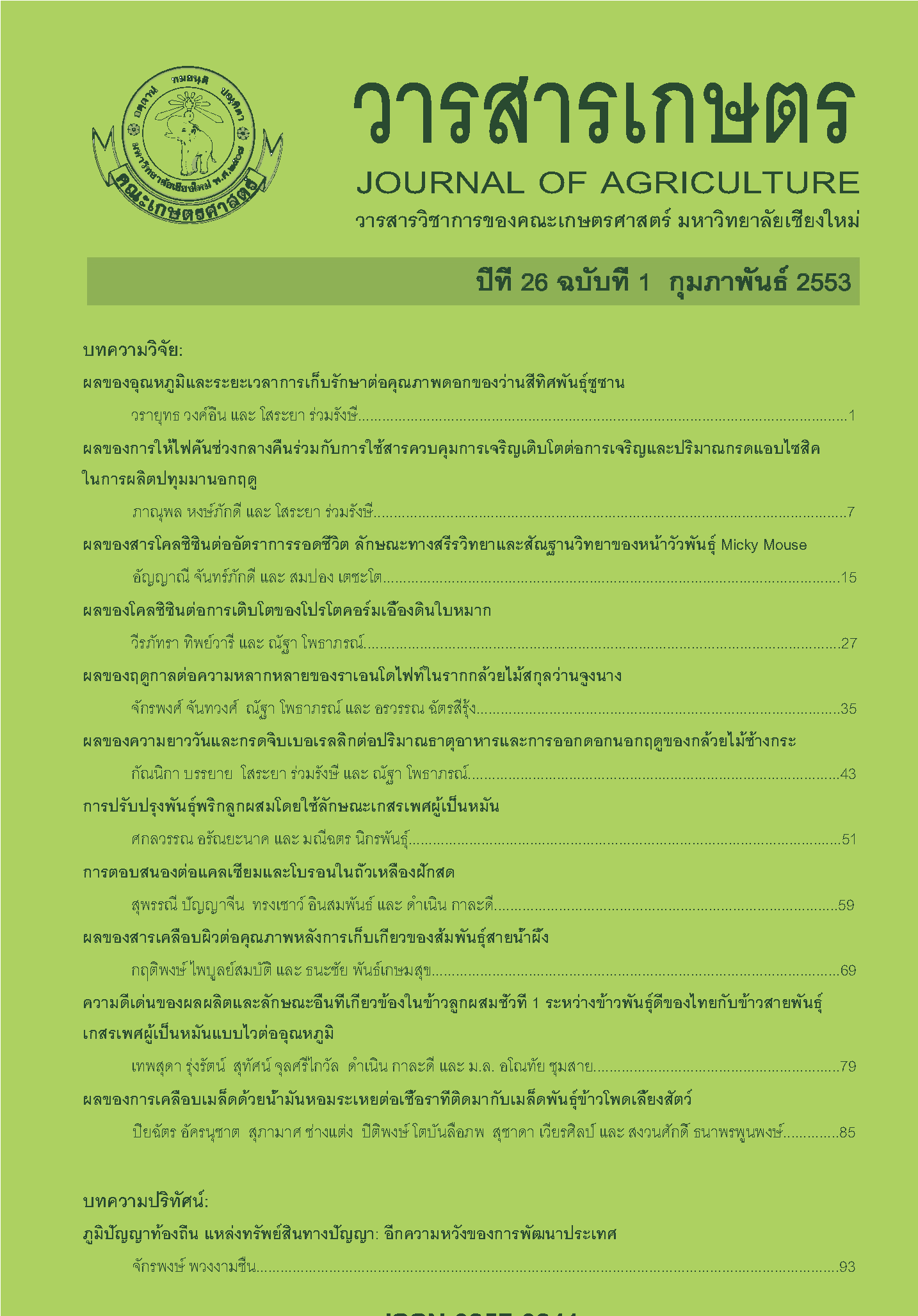ผลของการให้ไฟคั่นช่วงกลางคืนร่วมกับการใช้สารควบคุม การเจริญเติบโตต่อการเจริญและปริมาณกรดแอบไซสิค ในการผลิตปทุมมานอกฤดู
Main Article Content
บทคัดย่อ
การศึกษาผลของการให้ไฟคั่นช่วงกลางคืนร่วมกับการใช้สารควบคุมการเจริญเติบโตต่อการเจริญเติบโตและปริมาณกรดแอบไซสิค ในการผลิตปทุมมานอกฤดู ดำเนินการโดยวางแผนการทดลองแบบสปลิตพล็อต จำนวน 3 ซ้ำ ปัจจัยหลัก คือ 1) การให้แสงไฟธรรมชาติ และ 2) การให้ไฟคั่นช่วงกลางคืน ปัจจัยย่อยคือ การให้สารควบคุมการเจริญเติบโต 4 กรรมวิธี ได้แก่ 1) ชุดควบคุม ไม่ให้สาร 2) แช่สาร GA3100 มิลลิกรัมต่อลิตร 3) แช่สารฟลูริโดน 10 ไมโครโมลาร์ และ 4) แช่สาร GA3100 มิลลิกรัมต่อลิตร ร่วมกับฟลูริโดน 10 ไมโครโมลาร์ ผลการทดลองพบว่า การให้ไฟคั่นช่วงกลางคืน ไม่ส่งผลต่อการเจริญเติบโต ทั้งความสูง และพื้นที่ใบรวมของปทุมมา ขณะที่การให้สารควบคุมการเจริญเติบโตทำให้ต้นปทุมมา มีความสูงและพื้นที่ใบรวม แตกต่างกันอย่างมีนัยสำคัญทางสถิติ โดยการให้ GA3 ทำให้ต้นมีความสูงมากที่สุด การให้ไฟมีปฏิสัมพันธ์ร่วมกับการให้สารควบคุมการเจริญเติบโต ส่งผลให้ต้นมีความสูงและพื้นที่ใบรวมแตกต่างกัน อย่างมีนัยสำคัญทางสถิติ อย่างไรก็ตาม ทั้งการให้ไฟและการให้สารควบคุมการเจริญ กลับไม่ส่งผล ต่อปริมาณกรดแอบไซสิคในใบ หัวพันธุ์ และตุ้มรากสะสมอาหารของปทุมมา และปฏิสัมพันธ์ระหว่างการให้ไฟร่วมกับ การให้สารควบคุมการเจริญเติบโตไม่ส่งผลต่อปริมาณกรดแอบไซสิคในส่วนต่าง ๆ ของพืชด้วยเช่นกัน
Article Details
เอกสารอ้างอิง
เครือข่ายข่าวสารเทคโนโลยีหลังการเก็บเกี่ยว. 2550. ชูกลยุทธ์ผลิต"ปทุมมา"นอกฤดู ผ่าทางตันส่งออกไม้ดอกไทย. (ระบบออนไลน์). แหล่งข้อมูล: http://www.phtnet.org/news/view-news.asp?nID=58 (28 กรกฎาคม 2552).
อนงค์ พยัคฆัยหพล และ โสระยา ร่วมรังษี. 2549. ผลของวิธีการให้แสงไฟต่อการออกดอกนอกฤดูของปทุมมา. วารสารเกษตร 22(2): 131-140.
Bartels, P.G. and C.W. Watson. 1978. Inhibition of carotenoid synthesis by fluridone and norflurazon. Weed Sci. 26: 198-203.
De Hertogh, A.A. and M. Le Nard. 1993. The Physiology of Flower Bulbs. Elsevier Science Publishers, Amsterdam. 811 pp.
Fong, F. and J.A. Schiff. 1979. Blue-light-induced absorbance changes associated with carotenoids in Euglena. Planta. 146: 119-127.
Gamble, P.R. and J.E. Mullet. 1986. Inhibition of carotenoid accumulation and abscisic acid biosynthesis in fluridonee treated dark-grown barley. Eur. J. Biochem. 160: 117-121.
Hagiladi, A., N. Umiel and X.H. Yang. 1997. Curcuma alismatifolia. II. Effects of temperature and day length on the development of flower propagules. Acta Hort. 430: 755-761.
Hanks, G.R. 1979. Potential uses of plant growth regulators in bulbous ornamentals. New Bulletin, British Plant Growth Regulators Group 3: 5-16.
Hongpakdee, P., T. Ohyama and S. Ruamrungsri. 2009. Effects of production season on growth flower qualities and endogenous ABA levels in Curcuma alismatifolia Gagnep. pp. 276 In: RGJ-Ph.D. Congress X. TRF, Bangkok.
Khuankaew, T., T. Ohyama and S. Ruamrungsri. 2008. Effects of gibberellin application on growth and development of Curcuma alismatifolia Gagnep. Bull. Fac. Agric. Niigata Univ. 60(2): 135-140.
Kuehny, J. S., M.J. Sarmiento and P.C. Brach. 2002. Cultural studies in ornamental ginger. pp. 477-482. In: J. Janick and A. Whipkey (eds.). Trends in New Crops and New Uses. ASHS Press, Alexandria, VA.
Le Page Degivry, M.T. and G. Garello. 1992. In situ abscisic acid synthesis: a requirement for induction of embryo dormancy in Helianthus annuus. Plant Physiol. 98: 1386-1390.
Moe, R. and M. Bernard. 1986. Effect of various corm treatments on flowering of Liatris spicata Wild. Acta Hort. 177: 197-201.
Naor, V., J. Kigel, M. Ziv and M. Flaishman. 2005. A developmental pattern of flowering in colored Zantedeschia spp.: effects of bud position and gibberellin. J. Plant Growth Regul. 23: 269-279.
Popova, L.P and K.A. Riddle. 1996. Development and accumulation of ABA in fluridonee-treated and drought-stressed Vicia faba plants under different light conditions. Physiol. Planta. 98: 791-797.
Ruamrungsri, S., J. Uthaibutra, O. Wichailux and P. Apavatjrut. 2007. Planting date and night break treatment affected off-season flowering in Curcuma alistmatifolia Gegnep. Gardens’ Bulletin Singapore. 59(1-2): 173-182.
Saniewski, M., L. Kawa-Miszczak, E. Wegrzynowicz-Lesiak and H. Okubo. 1999. Gibberellin induces shoot growth and flowering in nonprecooled derooted bulbs of tulip (Tulipa gesneriana L.). J. Fac. Agr. Kyushu Univ. 43(3-4): 411-418.
Srivastava, L.M. 2001. Plant Growth and Development: Hormones and Environment. Academic Press, San Diego. 772 pp.
Su, W.R., W.S. Chen, M. Koshioka, L.N. Mander, L.S. Hung, W.H. Chen, Y.M. Fu and K.L. Huang. 2001. Changes in gibberellin levels in the flowering shoot of Phaleanopsis hybrida under high temperature conditions when flower development is blocked. Plant Physiol. Biochem. 39: 45-50.
Thomas, S.G., I. Rieu and C.M. Steber. 2005. Gibberellin metabolism and signaling. Vitam. Horm. 72: 289-338.
Vencill, W.K. 2002. Herbicide Handbook. 8th ed. Weed Science Society of America, Lawrence, 493 pp.
Walker-Simmons, M.K., P.A. Rose., L.R. Hogge and S.R. Abrams. 2000. Abscisic acid, ABA immunoassay and gas chromatography/mass spectrometry verification. pp 33-47. In: G.A. Tucker and J.A. Roberts (eds.). Plant Hormone Protocols (Methods in Molecular Biology). Humana Press, Totowa.
Yamazaki, H., T. Nishijima, Y. Yamato, M. Koshioka and H. Miura. 1999. Involvement of abscisic acid (ABA) in bulb dormancy of Allium wakegi Araki. I. Endogenous levels of ABA in relation to bulb dormancy and effects of exogenous ABA and fluridone. Plant Growth Regul. 29(3): 189-194.
Zeevaart, J.A.D. and R.A. Creelman. 1988. Metabolism and physiology of abscisic acid. Annu. Rev. Plant Physiol. Plant Mol. Biol. 39: 439-473.


